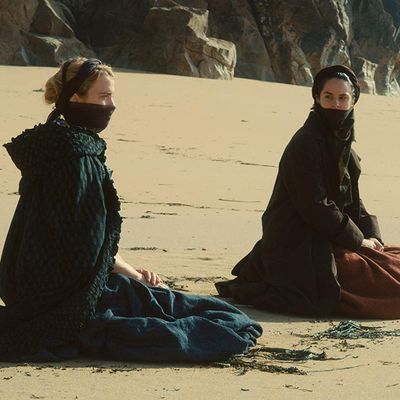
This review originally ran in February. We are republishing it on the occasion of the film’s release on Hulu.
Celine Sciamma’s lovely period romance Portrait of a Lady on Fire starts off as a film about looking, but its heart lies in less obvious, more suggestive cinematic elements like texture, mood, and sound. The movie is set sometime in the late 18th century, on a windswept island in Brittany where young painter Marianne (Noémie Merlant) has just arrived with an odd commission: She is to secretly paint young noblewoman Héloïse (Adèle Haenel), so that a prospective Milanese husband — who was previously betrothed to Héloïse’s sister, who killed herself — can see her and decide whether he wants her as a wife. Héloïse has just left a Benedictine convent, and, reluctant to marry so soon after receiving her freedom, has already spurned one painter. So Marianne slowly befriends Héloïse, pretending to be there simply as a walking companion, while also clandestinely painting her portrait, a trust exercise founded on betrayal. But Sciamma wisely underplays the potential melodrama of this arrangement; Héloïse is too smart to be taken in so easily, and the film’s interests lie elsewhere.
It’d be tempting, and not entirely off-point, to read Portrait of a Lady on Fire as a deconstruction of the male gaze. (There are even a number of overt allusions to Alfred Hitchcock’s Vertigo, plus some sly references to whether Héloïse smiles enough.) But the film isn’t nearly so schematic, or simplistic; it exists not to undermine an idea but to make us see a world anew. Héloïse lives in a huge empty house, where the unfurnished rooms and stone halls echo with the crackle of fireplaces and the rustle of dresses. Outside, all we hear is the blowing of the wind and the rushing of the waves. It all feels so lonely and desolate, and yet over the course of the film, this initially confining bleakness transforms into possibility, as we begin to understand that the emptiness surrounding Héloïse is a measure of her freedom, not a sign of her spiritual or marital deprivation. When Marianne first sees her, Héloïse breaks into a run toward a cliff overlooking the sea. “I’ve dreamt of that for years,” she says. “To die?” Marianne asks. “To run,” Héloïse replies.
The fine line between death and liberation is a great capital-R Romantic idea, as is the death-in-life of passion unfulfilled. Throughout, Marianne is haunted by a vision of Héloïse in a wedding dress, and “haunted” is the right word: All decked out in flowing white, this Héloïse might as well be a ghost, appearing at the end of darkened corridors, flashing into sight and then suddenly vanishing. The horror of looming domesticity is interwoven with something more immediate: the beauty of a life together, however fleeting it may be. The two women’s furtive glances at one another soon turn into desperate touches. The empty household, the sparsely populated setting, all make the blossoming of their love possible. A young housekeeper, Sophie (Luàna Bajrami), seems to be their only regular companion, and together the trio momentarily create a kind of family unit.
Sciamma has a great feel for structure, for emotional arcs, and for pinpoint-accurate catharses that nevertheless preserve the tantalizing enigma of her characters. The film is filled with moments of unforgettable intimacy and passion — there are at least three scenes where you could legitimately lean over to your companion and whisper, “That’s a portrait of a lady on fire” — but intimacy and passion don’t always result in understanding or clarity; often, they deepen the beloved’s mystery. As such, the tone is sober, delicate, deliberate. Portrait of a Lady on Fire builds and builds and builds, as we keep waiting for an explosion, a big emotional climax. And, not unlike with another great recent import, Pedro Almodóvar’s Pain and Glory, it arrives with the very last shot — which I won’t reveal other than to say it’s one of the finest pieces of acting and one of the most moving images I’ve seen in eons.
Don’t have Hulu yet? You can sign up here. (If you subscribe to a service through our links, Vulture may earn an affiliate commission.)


